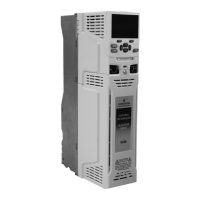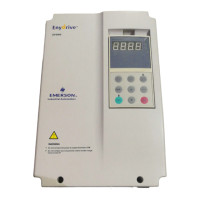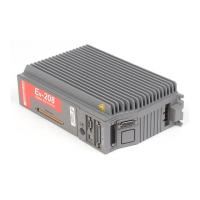Safety
information
Product
information
Mechanical
installation
Electrical
installation
Getting
started
User Menu A Commissioning
Advanced
Parameters
Diagnostics Optimization CT MODBUS RTU Technical Data
200 E300 Design Guide
Issue Number: 1
test has been completed successfully the mode is changed to Ur mode and Stator Resistance (B34) is saved to non-volatile memory. If Parameter
Cloning (N01) is set to 3 or 4 the Stator Resistance (B34) is also written to a non-volatile media card fitted in the drive. If the test fails the mode is
changed to Ur mode, but Stator Resistance (B34) is not updated.
4: Ur I (Resistance compensation, stator resistance measured at power-up)
Resistance compensation is used as in Ur S mode, but the Stator Resistance (B34) is only measured when the drive is enabled for the first time after
each power-up.
5: Square (Fixed boost with square characteristic)
A fixed square frequency to voltage characteristic is used as shown below. When the Output Frequency (J60) is below Motor Rated Frequency (B06)
the Output Voltage (J61) is given by:
Output Voltage (J61) = Low Frequency Voltage Boost (B12) + [Motor Rated Voltage (B03) - Low Frequency Voltage Boost (B12)] x (Output
Frequency (J60) / Motor Rated Frequency (B06))
2
]
Figure 8-4 Fixed Boost with Linear characteristic
Action On Enable (B09) can be used to get the drive to perform a phasing angle test when it is enabled. This test can be used when a non-absolute
encoder is used for motor control feedback in RFC-S mode. The phasing test will measure and modify Position Feedback Phase Angle (C13), so that
the correct offset is applied to run the motor with the non-absolute encoder. The test can be selected to occur after power-up and each time the
position feedback is re-initialized. It is not necessary to perform the test on every enable, but this can be selected as shown in the table below. If the
motor has significant cogging torque, and is not locked during the test, it is suggested that a long test is selected, otherwise a short test can be used.
It should be noted that the motor inductances (Transient Inductance Ld (B33) and No Load Lq (B37) are checked before the test is carried out, and if
the difference is not sufficient (see Inductance) then the drive will trip. Therefore, if the motor inductances have not been measured with auto-tuning
or changed from their default values of zero the drive will trip when the drive is enabled.
Low
Frequency
Voltage Boost
(B12)
Rated Voltage
(B03)/2
Rated Voltage
(B03)
Output Frequency
(J60)
Rated Frequency
(B06)
Rated Frequency
(B06)/2
Output Voltage
(J61)
Fixed boost frequency to voltage characteristic
B09 Action On Enable
Mode RFC-S
Minimum 0 Maximum 4
Default 0 Units
Type 8 Bit User Save Update Rate Background read
Display Format Standard Decimal Places 0
Coding RW, TE
Value Text
0 Disabled
1 Short
2 Short Once
3 Long
4 Long Once

